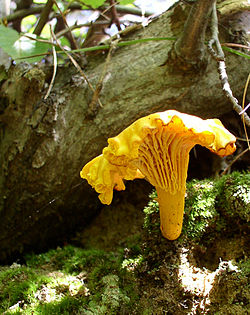Cantharellaceae
Cantharellaceae | |||||||||||
|---|---|---|---|---|---|---|---|---|---|---|---|
 Cantharellus cibarius | |||||||||||
Classificação científica | |||||||||||
| |||||||||||
| Géneros | |||||||||||
Cantharellus Craterellus | |||||||||||
Cantharellaceae é uma família de fungos. Inclui os géneros Cantharellus, Craterellus, Goossensia, Parastereopsis, e Pterygellus. Cantharellus é um género de cogumelos comestíveis desta família particularmente popular. Os membros desta família têm corpo em forma de taça ou funil, e são quase sempre encontrados em zonas arborizadas.
Espécies |
| Cantharellales |
| ||||||||||||||||||||||||||||||||||||||||||||||||||||||
- Este artigo foi inicialmente traduzido do artigo da Wikipédia em inglês, cujo título é «Cantharellaceae», especificamente desta versão.